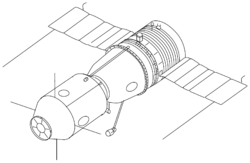Kosmos 869
| Kosmos 869 (Космос-869) | |
| Modell | Sojuz 7K-S |
|---|---|
| Tillverkare | RKK Energia |
| Färdens tid | ~18 dagar |
| Massa | 6 800 kg |
| NSSDC-ID | 1976-114A[1] |
| Uppskjutning | |
| Startplats | Bajkonur 1/5 |
| Start | 29 november 1976, 16:04 UTC |
| Raket | Sojuz |
| Landning | |
| Landning | 17 december 1976, 10:31 UTC |
| Omloppsbana | |
| Apogeum | 289 km |
| Perigeum | 209 km |
| Banlutning | 51,7° |
Kosmos 869 (ryska: Космос-869) var en obemannad testflygning i Sovjetunionens Sojuzprogram. Farkosten sköts upp från Kosmodromen i Bajkonur den 29 november 1976 med en Sojuz-raket.
Flygningen gjordes för att testa en ny variant av Sojuz kallad Sojuz 7K-S. Farkosten återinträdde i jordens atmosfär och landade i Sovjetunionen arton dagar efter uppskjutningen.
Referenser
- Den här artikeln är helt eller delvis baserad på material från engelskspråkiga Wikipedia, tidigare version.
Noter
- ^ ”NASA Space Science Data Coordinated Archive” (på engelska). NASA. https://nssdc.gsfc.nasa.gov/nmc/spacecraft/display.action?id=1976-114A. Läst 28 februari 2020.
| |||||||||||||||||||||||||||||||||||||||||||||||||||||||||||||||||||||||||||||||||||||||||
Media som används på denna webbplats
Soyuz-TM spacecraft. Compare the antennas on the orbital module to those on Soyuz-T. Differences reflect the change from the Igla rendezvous system used on Soyuz-T to the Kurs rendezvous system used on Soyuz-TM.
Apollo-Soyuz Test Project (ASTP) Soyuz. The APAS-75 docking unit is located at left.
The Soyuz TMA-04M spacecraft is seen after being rolled out by train to the launch pad at the Baikonur Cosmodrome in Kazakhstan, May 13, 2012. The launch of the Soyuz spacecraft, with Expedition 31 Soyuz Commander Gennady Padalka, Flight Engineer Sergei Revin of Russia and NASA Flight Engineer Joe Acaba, is scheduled for 9:01 a.m., May 15 (Kazakhstan time).
Soyuz-A manned spacecraft concept (1963). It was to have been part of the Soyuz A-B-C circumlunar complex.









